Parkinson's Disease
exp date isn't null, but text field is
Clinical Description
Parkinsonism is a syndrome characterized by tremor, rigidity, bradykinesia and postural disturbances. It may be primary, i.e., Parkinson's disease, or secondary, i.e., drug-induced or due to uncommon disorders that may initially resemble Parkinson's disease.
Treatment
General Measures
- Educate the patient on the condition. General supportive therapy and advice about lifestyle modification, physiotherapy, and occupational therapy.
The objective of treatment is to:
- Minimize disabling symptoms,
- promote functional abilities
- prevent complications and avoid serious drug-induced side effects, and
- exclude secondary forms.
Note: Set therapeutic targets so that the patient is functioning as well as possible.
PRIMARY PARKINSONISM
Bradykinesia, rigidity and postural disturbance:
- Carbidopa/levodopa, 25/100 mg, oral, ½ tablet 8 hourly. Increase dose in consultation with a specialist.
- If optimal control has not been achieved, consider an alternative diagnosis or changing to a drug containing a higher dose of levodopa: Carbidopa/levodopa 25/250 mg. Specialist initiated.
DRUG-INDUCED PARKINSONISM
- Anticholinergics have a very small role in this setting and should be used with caution.
- Anticholinergic agent, e.g.: Orphenadrine, oral, 50 mg 8 hourly.
Tremor only:
Consider anticholinergic agent, e.g.:
- Orphenadrine, oral, 50mg 8 hourly. Increase gradually according to clinical response or maximum dose of 400mg daily
- Usual dose: 150-250 mg q24h.
Acute dystonic reaction
- Usually follows administration of dopamine antagonistic drug, e.g., Metoclopramide and Phenothiazines. Anticholinergic agent, e.g., Biperiden, IM/IV, 2 mg. Repeat as necessary.
REFERRAL
- If there is no improvement or poor control with treatment.
- Increasing on/off phenomenon.
